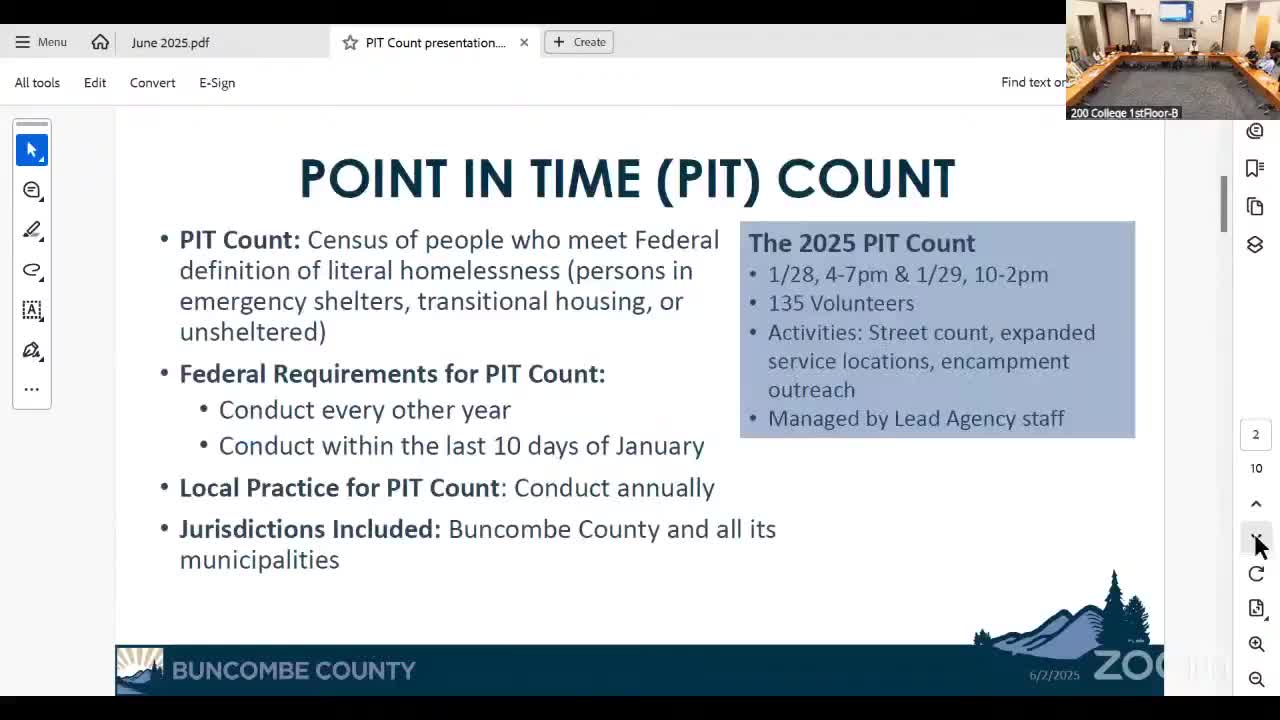Asheville conducts annual homeless count revealing rising unsheltered population
June 07, 2025 | Buncombe County, North Carolina
This article was created by AI summarizing key points discussed. AI makes mistakes, so for full details and context, please refer to the video of the full meeting. Please report any errors so we can fix them. Report an error »

The Buncombe County Justice Resource Advisory Council convened on June 7, 2025, to discuss the results of the recent Point in Time Count, a crucial census of individuals experiencing homelessness in the area. This annual count, which aligns with federal requirements, aims to provide a snapshot of homelessness across Buncombe County, including Asheville and its municipalities.
During the meeting, officials reported a concerning increase in the number of unsheltered individuals, rising by 109 to a total of 328. This uptick is partly attributed to the aftermath of Tropical Storm Helene, which displaced many residents. Notably, 116 of those counted as unsheltered indicated that the storm was a direct cause of their current situation. The total number of individuals experiencing homelessness, including those in emergency shelters and transitional housing, reached 2,303, a slight increase from the previous year.
The meeting highlighted the ongoing challenges in providing adequate shelter, as the number of available beds continues to fall short of the demand. The count revealed that on the night of January 28, there were more unhoused individuals than shelter beds available, underscoring the urgent need for additional resources and support.
Demographic data from the count showed disparities in the racial composition of those experiencing homelessness. While Black and African American individuals represent only 6% of the county's population, they accounted for 17.6% of the respondents in the Point in Time Count. This disparity raises concerns about equity in access to housing and support services.
The council also noted a significant decrease in the number of families responding to the count, which may reflect changes in housing situations post-storm. Many families may have found temporary solutions through FEMA's Transitional Sheltering Assistance program, which, while not counted under HUD's definitions of homelessness, indicates a shift in how families are navigating housing instability.
As the council moves forward, the data collected will inform strategies to address homelessness in the community, focusing on equitable access to resources and support for all residents. The meeting underscored the importance of community involvement, with 135 volunteers participating in this year's count, demonstrating a collective commitment to tackling homelessness in Buncombe County.
During the meeting, officials reported a concerning increase in the number of unsheltered individuals, rising by 109 to a total of 328. This uptick is partly attributed to the aftermath of Tropical Storm Helene, which displaced many residents. Notably, 116 of those counted as unsheltered indicated that the storm was a direct cause of their current situation. The total number of individuals experiencing homelessness, including those in emergency shelters and transitional housing, reached 2,303, a slight increase from the previous year.
The meeting highlighted the ongoing challenges in providing adequate shelter, as the number of available beds continues to fall short of the demand. The count revealed that on the night of January 28, there were more unhoused individuals than shelter beds available, underscoring the urgent need for additional resources and support.
Demographic data from the count showed disparities in the racial composition of those experiencing homelessness. While Black and African American individuals represent only 6% of the county's population, they accounted for 17.6% of the respondents in the Point in Time Count. This disparity raises concerns about equity in access to housing and support services.
The council also noted a significant decrease in the number of families responding to the count, which may reflect changes in housing situations post-storm. Many families may have found temporary solutions through FEMA's Transitional Sheltering Assistance program, which, while not counted under HUD's definitions of homelessness, indicates a shift in how families are navigating housing instability.
As the council moves forward, the data collected will inform strategies to address homelessness in the community, focusing on equitable access to resources and support for all residents. The meeting underscored the importance of community involvement, with 135 volunteers participating in this year's count, demonstrating a collective commitment to tackling homelessness in Buncombe County.
View full meeting
This article is based on a recent meeting—watch the full video and explore the complete transcript for deeper insights into the discussion.
View full meeting
